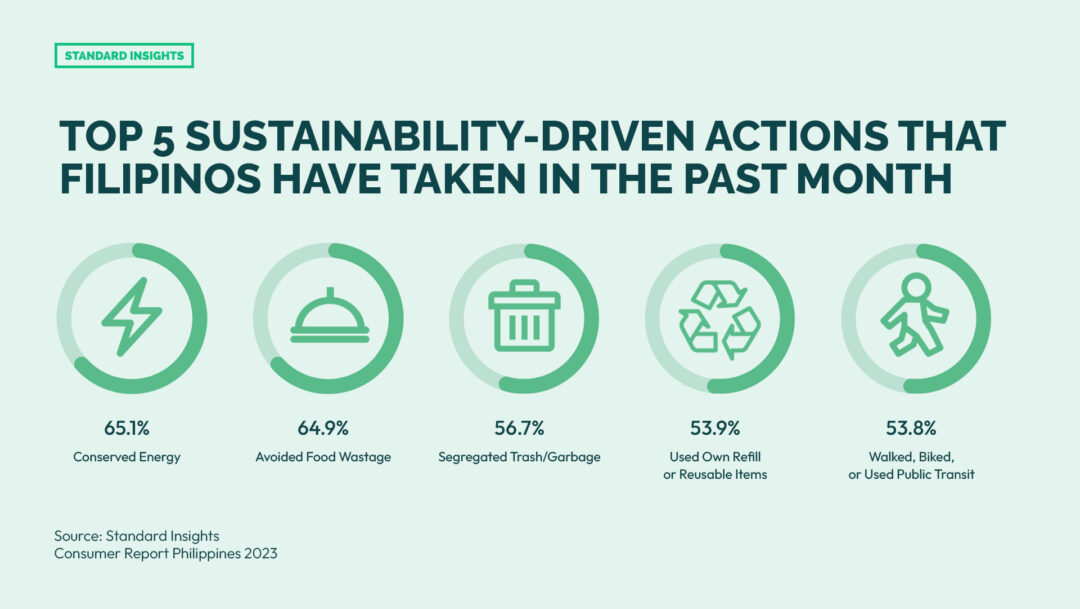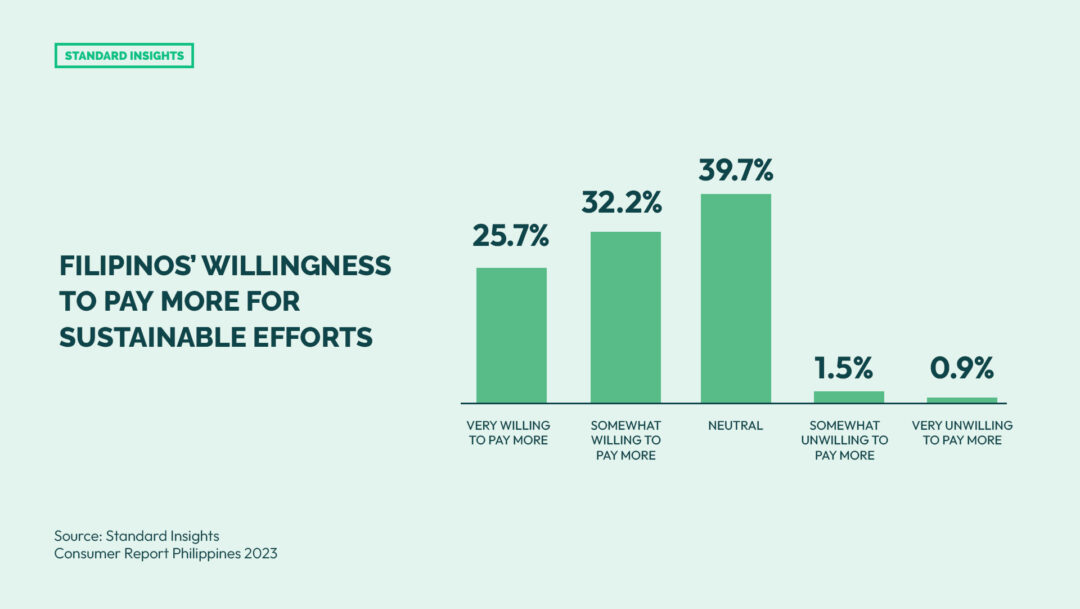Environmental sustainability in the Philippines has long been a critical concern, as the country grapples with the consequences of climate change. Located in Southeast Asia, along the typhoon belt in the Pacific, the archipelagic nation is among the countries most affected by this global phenomenon. Rising temperatures and sea levels have caused problems for its coastal areas and agricultural lands, threatening food security and livelihoods.
In fact, according to the Philippine Statistics Authority, from 2010 to 2019, the damage caused by natural and extreme events and disasters in the country totalled PHP 463 billion (USD 8.27 billion), with agriculture accounting for 62.7% of the total at PHP 290 billion.

As the challenges of environmental degradation continue to mount, the importance of environmental sustainability in the Philippines has become an increasingly prominent concern for the Filipino people. In light of this, Standard Insights has surveyed the local population to learn more about their thoughts and opinions on environmental issues. Discover the results and our analysis below.
The Rich History of Environmental Sustainability in the Philippines
For centuries, Filipinos have been practising sustainable farming techniques such as crop rotation and natural fertilizers to ensure their lands remain fertile for future generations. Indigenous communities were also known to practice permaculture, using methods such as planting multiple species together to promote biodiversity and increase productivity.
Today, environmental sustainability in the Philippines is still a top priority. From grassroots organizations to government-led initiatives, there are numerous efforts geared toward protecting and preserving the Philippine environment. These include programs aimed at promoting sustainable agriculture practices, restoring mangroves and coral reefs, as well as educating Filipino citizens about environmental issues.
Environmental Issues in the Philippines

Despite the impressive efforts made by Filipinos to promote sustainable development, there are still a number of environmental issues facing the country.
Air & Water Pollution
Air pollution is a pressing environmental concern in the Philippines, particularly in urban areas where high levels of vehicle emissions and industrial activities contribute to the problem. According to the World Health Organization’s health and environment scorecard, the country’s annual mean for fine particulate matter is 24 micrograms per cubic meter (µg/m³), which far exceeds the recommended maximum level of 5 µg/m³. This poor air quality not only results in respiratory problems and other health issues but also has negative effects on crops and natural ecosystems.
In addition, marine pollution poses a worrisome threat to the Philippines, as coastal areas and marine habitats face the damaging effects of plastic pollution, oil spills, and untreated sewage discharge. Shockingly, the country generates a staggering 2.7 million tons of plastic waste annually, driven by unsustainable plastic consumption and an inefficient recycling system. This rampant plastic waste harms marine biodiversity and endangers the livelihoods of fishing communities
Deforestation
Deforestation stands as another prominent environmental challenge in the Philippines, with significant areas of forests being cleared each year for agricultural purposes or to make way for infrastructure projects. In fact, in 2010, the Philippines had 13.2 million hectares of natural forest, covering approximately 62% of its land area. However, in 2021 alone, the country lost 37.7 thousand hectares of natural forest, resulting in a staggering emission of 22.5 million metric tons of CO₂.
This destructive activity has resulted in the loss of critical habitat for endangered species, soil erosion, and disruption of water sources. Additionally, it has led to the displacement of indigenous communities who rely on these resources for their livelihoods. Despite the government’s efforts to combat illegal mining and logging, enforcement and monitoring remain daunting tasks due to limited resources and corruption issues.
Sea Level Rise
The Philippines is vulnerable to the impacts of climate change, including sea level rise. In fact, the country has witnessed sea level rise at an alarming rate of 60 centimeters, which is about three times higher than the global average. This poses a significant threat to low-lying coastal areas and small island communities, resulting in increased coastal erosion, loss of land, and intrusion of saltwater into freshwater sources. The implications of this phenomenon are severe, as it adversely impacts agriculture, food security, and human settlements in these vulnerable areas. Displacement of communities and increased vulnerability to natural disasters such as storm surges and typhoons are among the dire consequences.
Threats to Environmental Activists
Environmental activists in the Philippines face significant threats to their safety and well-being. According to a report by Global Witness, the Philippines ranked as the 4th deadliest country in the world for land and environmental defenders, and the deadliest in Asia. Many have been subjected to harassment, violence, and even extrajudicial killings for their efforts to protect the environment and advocate for sustainable development. The lack of adequate protection and legal mechanisms to safeguard the rights of environmental defenders poses a challenge to addressing environmental issues in the country, as it creates a chilling effect on activism and hampers efforts to hold those responsible for environmental destruction accountable.
Current Energy Consumption in the Philippines
About The Philippines’ energy consumption, the country is heavily reliant on traditional energy sources like coal, oil, and gas. These fossil fuel sources account for more than 70% of the country’s electricity generation, with renewable sources such as solar and wind representing only a small fraction. Specifically, in 2019, the largest share of the country’s entire energy consumption came from petroleum and other liquids (45%), followed by coal (36%), natural gas (7%), non-hydropower renewables (7%), and hydroelectricity (4%).
The dependence on fossil fuels has engendered tremendous surges in greenhouse gas emissions, making the energy sector unsustainable. This caused a massive pollution problem, further damaging air quality and exacerbating environmental deterioration—ultimately impacting people’s livelihoods and health in this country.
Government Initiative in Investing in Green Energy

In recent years, the Philippine government has made a concerted effort to reduce its reliance on fossil fuels and invest in renewable energy sources such as solar and wind power. The country’s Renewable Energy Act of 2008 mandates that at least 15% of total energy generated must come from renewable sources by 2030. To meet this goal, the government has implemented incentive programs and initiatives to promote the development of solar, wind, biomass, geothermal, small hydroelectric, and other renewable energy sources.
Corporate Responsibility Towards Environmental Sustainability
In the Philippines, corporate responsibility for environmental sustainability is becoming increasingly important. Companies are being called upon to ensure environmentally responsible practices and strive for a more sustainable future for the country. This includes reducing carbon emissions, engaging in renewable energy initiatives, protecting local ecosystems, and ensuring that their operations do not have negative impacts on the environment. Companies that take such measures demonstrate their commitment to safeguarding the planet while contributing to economic growth and creating a better quality of life for Filipinos.
In our Consumer Report Philippines 2023, we surveyed over 1,000 Filipino respondents, revealing that an impressive 88.7% believe companies should take a proactive and transparent approach to tackle the world’s environmental challenges.

This push for environmental sustainability in the Philippines has led private businesses in the country to take steps to reduce their environmental footprint and become more sustainable. Companies like Globe Telecom, Ayala Land, and San Miguel Corporation have made great strides toward energy efficiency by investing in clean energy sources such as solar and wind power.
The demand for green energy is expected to continue growing in the Philippines, as businesses, communities, and individuals recognize the benefits of clean energy sources for the environment and economy. With increased investments in renewable energy sources, the Filipino people are taking decisive action toward preserving their natural resources for future generations.
Consumers On The Importance of Environmental Sustainability
Consumers are also increasingly aware of the importance of environmental sustainability in the Philippines. Many Filipinos are now more mindful of their ecological footprint and are becoming more conscious about reducing their own waste. This indicates a greater shift in consumer behaviour towards sustainability and environmental conservation.
This sentiment is reflected in a finding from our study, wherein a majority of Filipinos (91.8%) believe that their efforts to sustain the environment will have a significant impact on whether or not the planet gets better or becomes worse.

Specifically, when asked about sustainability-driven measures they had regularly carried out during the previous month, 65.1% of them said they had conserved energy, 64.9% said they had avoided food waste, and 56.7% said they had segregated their trash/garbage.

Additionally, when asked about sustainability-driven actions that they had consciously done over the past year, many Filipinos (66.3%) stated that they had purchased products/services solely for the aim of supporting eco-friendly & ethical practices. Meanwhile, 51.9% of them asserted to have promoted a brand to friends and families for its eco-friendly and ethical practices. This reflects a shift in Filipino consumer preferences toward greener and more sustainable shopping.

This is also evidenced by the fact that 57.9% of Filipino consumers are willing to pay extra to cover the expenses associated with the sustainable and ethical production of goods and services.

Conclusion
In conclusion, environmental sustainability in the Philippines has a rich history, with a long tradition of sustainable farming practices and indigenous knowledge of permaculture. However, the country still faces significant environmental challenges, including air and water pollution, deforestation, sea level rise, and threats to environmental activists. The reliance on fossil fuels for energy generation has also led to greenhouse gas emissions and pollution problems.
Despite these challenges, there are government-led initiatives and grassroots efforts aimed at promoting environmental sustainability in the Philippines, including programs focused on sustainable agriculture, marine conservation, and renewable energy. However, more action is needed to address these pressing environmental issues and ensure a sustainable future for the Philippines. It is crucial to prioritize the protection and preservation of the Philippine environment, promote sustainable practices, and provide adequate protection and support for environmental defenders. Only through collective efforts and sustained action can the Philippines continue its rise toward a more environmentally sustainable future.
Get reliable market research in the Philippines with real consumer insights. Know what Filipinos want and feel, and make informed decisions.




